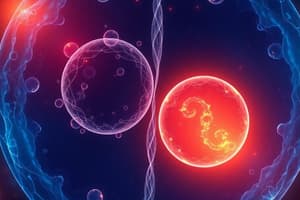Podcast
Questions and Answers
What is the primary function of mitosis?
What is the primary function of mitosis?
- To form two genetically identical diploid daughter cells (correct)
- To produce four genetically unique haploid cells
- To ensure genetic variation in offspring
- To reduce the chromosome number by half
Which phase of meiosis is characterized by crossing over?
Which phase of meiosis is characterized by crossing over?
- Prophase I (correct)
- Anaphase II
- Telophase II
- Metaphase I
What is a potential consequence of chromosomal abnormalities?
What is a potential consequence of chromosomal abnormalities?
- Enhanced fertility in organisms
- Normal functioning of all body systems
- Increased genetic stability in offspring
- Various health problems (correct)
Which of the following is a type of aneuploidy?
Which of the following is a type of aneuploidy?
During which phase of mitosis do sister chromatids separate?
During which phase of mitosis do sister chromatids separate?
What is the outcome of meiosis II?
What is the outcome of meiosis II?
What type of chromosomal abnormality involves the loss of a portion of a chromosome?
What type of chromosomal abnormality involves the loss of a portion of a chromosome?
Which of the following is true about meiosis?
Which of the following is true about meiosis?
Flashcards
What is meiosis?
What is meiosis?
A specialized type of cell division where a single diploid parent cell produces four genetically unique haploid daughter cells.
What is crossing over?
What is crossing over?
The exchange of genetic material between homologous chromosomes during prophase I of meiosis.
What are chromosomal abnormalities?
What are chromosomal abnormalities?
Abnormalities in the number or structure of chromosomes, potentially leading to health issues.
What is aneuploidy?
What is aneuploidy?
Signup and view all the flashcards
What is a chromosome deletion?
What is a chromosome deletion?
Signup and view all the flashcards
What is a chromosome duplication?
What is a chromosome duplication?
Signup and view all the flashcards
What is mitosis?
What is mitosis?
Signup and view all the flashcards
What happens during metaphase?
What happens during metaphase?
Signup and view all the flashcards
Study Notes
Mitosis
- Mitosis is a type of cell division that produces two genetically identical diploid daughter cells from a single diploid parent cell.
- It is crucial for growth, repair, and asexual reproduction in many organisms.
- The process involves several distinct phases:
- Interphase: The cell grows, replicates its DNA, and prepares for division.
- Prophase: Chromosomes condense and become visible, the nuclear envelope breaks down, and the mitotic spindle begins to form.
- Metaphase: Chromosomes align along the metaphase plate (equator of the cell).
- Anaphase: Sister chromatids separate and move to opposite poles of the cell.
- Telophase: Chromosomes decondense, the nuclear envelope reforms, and the cell begins to divide.
- Cytokinesis: The cytoplasm divides, resulting in two daughter cells.
- Mitosis ensures that each daughter cell receives a complete and identical set of chromosomes.
Meiosis
- Meiosis is a specialized type of cell division that produces four genetically unique haploid daughter cells from a single diploid parent cell.
- It is essential for sexual reproduction, generating gametes (sperm and eggs) with half the number of chromosomes compared to the parent cell.
- Meiosis involves two rounds of division:
- Meiosis I: Homologous chromosomes separate, reducing the chromosome number by half. Includes prophase I (crossing over), metaphase I, anaphase I, and telophase I.
- Meiosis II: Sister chromatids separate, similar to mitosis. Includes prophase II, metaphase II, anaphase II, and telophase II.
- Crossing over during prophase I is a key mechanism for genetic variation. It involves the exchange of genetic material between homologous chromosomes.
- Meiosis results in genetic diversity among the gametes, contributing to genetic variation in offspring.
Chromosomal Abnormalities
- Chromosomal abnormalities occur when there are alterations in the number or structure of chromosomes.
- These abnormalities can arise during meiosis or mitosis, potentially leading to various health problems.
- Numerical abnormalities:
- Aneuploidy: An abnormal number of chromosomes, such as monosomy (one copy) or trisomy (three copies).
- Down syndrome (trisomy 21) is an example of aneuploidy.
- Polyploidy: Multiple sets of chromosomes; common in plants, less frequent in animals.
- Aneuploidy: An abnormal number of chromosomes, such as monosomy (one copy) or trisomy (three copies).
- Structural abnormalities:
- Deletions: Loss of a portion of a chromosome.
- Duplications: Presence of a repeated segment on a chromosome.
- Inversions: A segment of a chromosome is reversed.
- Translocations: A segment of one chromosome breaks off and attaches to another.
- Consequences of chromosomal abnormalities can vary greatly, ranging from no observable effects to severe developmental disorders, such as intellectual disabilities, physical malformations, and increased risks of genetic diseases.
- Factors that can increase the risk of chromosomal abnormalities include advanced parental age and exposure to mutagens (e.g., radiation).
- Genetic testing can detect chromosomal abnormalities in individuals or embryos, aiding in diagnosis and management of the condition.
- Diagnosis and management of chromosomal abnormalities often involve clinical genetic counseling to support individuals and families.
Studying That Suits You
Use AI to generate personalized quizzes and flashcards to suit your learning preferences.




